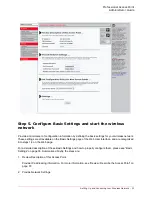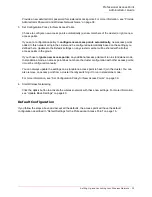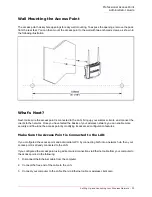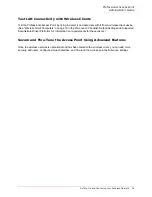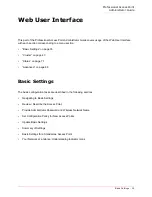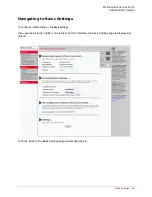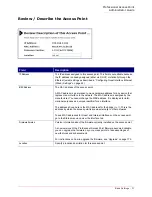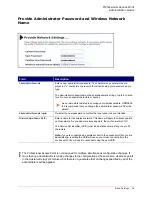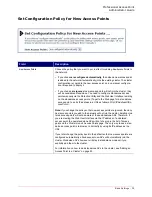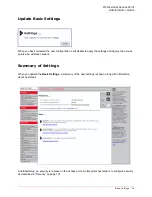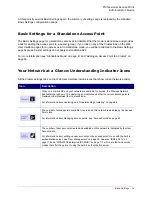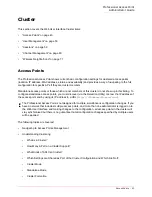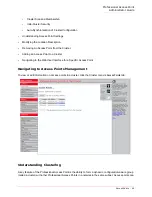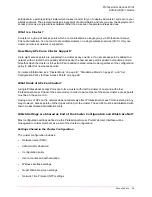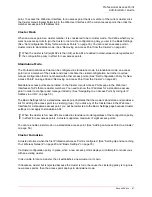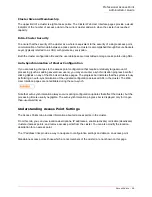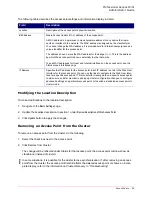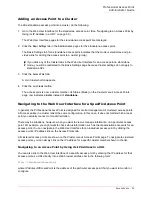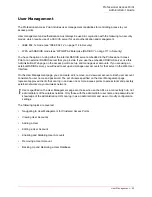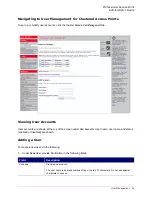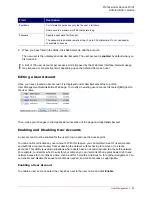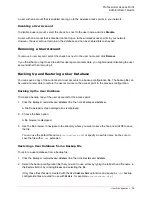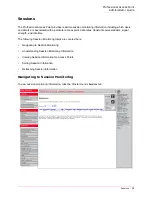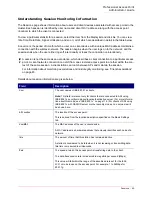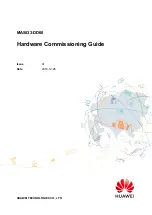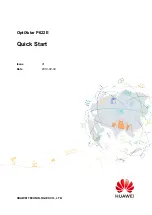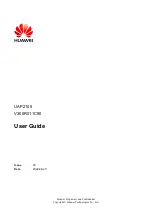
Professional Access Point
Administrator Guide
Access Points - 45
participate in a self-organizing cluster which makes it easier for you to deploy, administer, and secure your
wireless network. The cluster provides a single point of administration and lets you view the deployment of
access points as a single wireless network rather than a series of separate wireless devices.
What is a Cluster?
A cluster is a group of access points which are coordinated as a single group via Professional Access
Point administration. You cannot create multiple clusters on a single wireless network (
SSID
). Only one
cluster per wireless network is supported.
How Many APs Can a Cluster Support?
Up to eight access points are supported in a cluster at any one time. If a new access point is added to a
network with a cluster that is already at full capacity, the new access point is added in
standalone mode
.
Note that when the cluster is full, extra APs are added in stand-alone mode regardless of the configuration
policy in effect for new access points.
For related information, see “Cluster Mode” on page 47, “Standalone Mode” on page 47, and “Set
Configuration Policy for New Access Points” on page 39.
What Kinds of APs Can Cluster?
A single Professional Access Point can form a cluster with itself (a cluster of one) and with other
Professional Access Points of the same model. In order to be members of the same cluster, access points
must be on the same
LAN.
Having a mix of APs on the network does not adversely affect Professional Access Point clustering in any
way. However, access points of other types will not join the cluster. Those APs must be administered with
their own associated administration tools.
Which Settings are Shared as Part of the Cluster Configuration and Which Are Not?
Most configuration settings defined via the Professional Access Point Web User Interface will be
propagated to cluster members as a part of the
cluster configuration
.
Settings Shared in the Cluster Configuration
The cluster configuration includes:
•
Network name (SSID)
•
Administrator Password
•
Configuration policy
•
User accounts and authentication
•
Wireless interface settings
•
Guest Welcome screen settings
•
Network Time Protocol (NTP) settings
Summary of Contents for Instant802 APSDK
Page 1: ...Professional Access Point Administrator Guide R46 1224 00 rev 2 0 07 06...
Page 2: ......
Page 4: ...Professional Access Point Administrator Guide iv...
Page 8: ...Professional Access Point Administrator Guide viii...
Page 42: ...Professional Access Point Administrator Guide Basic Settings 42...
Page 52: ...Professional Access Point Administrator Guide Access Points 52...
Page 58: ...Professional Access Point Administrator Guide User Management 58...
Page 62: ...Professional Access Point Administrator Guide Sessions 62...
Page 70: ...Professional Access Point Administrator Guide Channel Management 70...
Page 88: ...Professional Access Point Administrator Guide Neighboring Access Points 88...
Page 96: ...Professional Access Point Administrator Guide Ethernet Wired Settings 96...
Page 120: ...Professional Access Point Administrator Guide Security 120...
Page 128: ...Professional Access Point Administrator Guide Virtual Wireless Networks 128...
Page 134: ...Professional Access Point Administrator Guide Radio 134...
Page 138: ...Professional Access Point Administrator Guide MAC Filtering 138...
Page 152: ...Professional Access Point Administrator Guide Quality of Service 152...
Page 160: ...Professional Access Point Administrator Guide Wireless Distribution System 160...
Page 164: ...Professional Access Point Administrator Guide Time Protocol 164...
Page 170: ...Professional Access Point Administrator Guide SNMP 170...
Page 290: ...Professional Access Point Administrator Guide Configuration Troubleshooting 290...
Page 298: ...Professional Access Point Administrator Guide Regulatory Information 298...
Page 328: ...Professional Access Point Administrator Guide Index 328...

